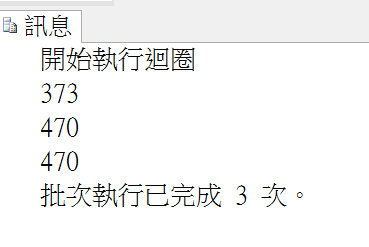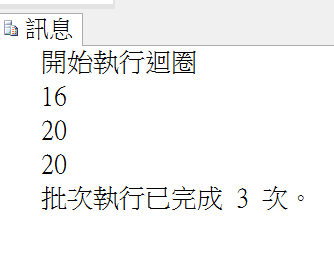下午協助同事抓SQL資料庫效能問題,暫時沒有頭緒,不過碰上了已經在記憶體中忘光的SQL 2012新功能(對不起老師): 順序物件(Sequence),來筆記,順便觀察快取設定對取號效能的影響。
重新查了一下順序物件的用法,還蠻適合使用在要號的邏輯中,話不多說,直接在Tempdb開三個順序物件(seq1,seq2,seq3),並且新增三個資料表t1,t2,t3。
- seq1設定no cache
- seq2設定cache 100
- seq3使用預設
use tempdb
create sequence seq1
as int
start with 1
increment by 1
no cache;
create sequence seq2
as int
start with 1
increment by 1
cache 100;
create sequence seq3
as int
start with 1
increment by 1;
create table t1(c1 int)
create table t2(c1 int)
create table t3(c1 int)
NO CACHE: 依序寫入1,000筆資料3次:
declare @start datetime = getDate();
declare @seq int = 0;
declare @i int = 1;
while @i < 1000 begin
select @seq = next value for seq1
insert into t1 VALUES(@seq)
set @i += 1;
end;
declare @end datetime = getDate();
declare @diff int = datediff(ms, @start, @end);
print @diff;
GO 3
執行結果:

CACHE 100: 依序寫入1,000筆資料3次:
declare @start datetime = getDate();
declare @seq int = 0;
declare @i int = 1;
while @i < 1000 begin
select @seq = next value for seq2
insert into t2 VALUES(@seq)
set @i += 1;
end;
declare @end datetime = getDate();
declare @diff int = datediff(ms, @start, @end);
print @diff;
GO 3
執行結果:

預設CACHE: 依序寫入1,000筆資料3次:
declare @start datetime = getDate();
declare @seq int = 0;
declare @i int = 1;
while @i < 1000 begin
select @seq = next value for seq3
insert into t3 VALUES(@seq)
set @i += 1;
end;
declare @end datetime = getDate();
declare @diff int = datediff(ms, @start, @end);
print @diff;
GO 3
執行結果:
總結:
| Cache選擇 | 第一次(ms) | 第二次(ms) | 第三次(ms) |
| NO CACHE | 373 | 470 | 470 |
| CACHE 100 | 13 | 13 | 13 |
| 預設CACHE | 16 | 20 | 20 |
- 確保不會因電源中止導致跳號留下遇缺不補,也許我們會設定NO CACHE Sequence,每一次要號都要寫到Disk,可能有一點點的機會影響到效能。
- 但,1,000筆也才差0.3秒,排除涉案可能。
排好隊才能看表演。
